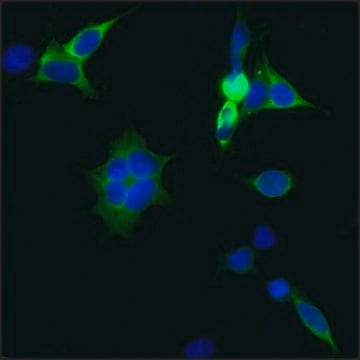CAS9PROT
Cas9 Protein
from Streptococcus pyogenes, recombinant, expressed in E. coli, 1X NLS
Synonym(s):
Cas9, SpCas9, SpyCas9
Sign Into View Organizational & Contract Pricing
All Photos(1)
About This Item
UNSPSC Code:
12352202
NACRES:
NA.51
Recommended Products
recombinant
expressed in E. coli
Quality Level
Assay
≥95% (SDS-PAGE)
form
lyophilized powder
packaging
pkg of 1 kit (3 components)
application(s)
CRISPR
shipped in
ambient
storage temp.
−20°C
General description
CAS9, also known as cas5 and csn1, is the signature gene of the type II clustered regularly interspaced short palindromic repeats (CRISPR)-RuvC (RNase H-like fold) cas system. CAS9 contains 1388 amino acids. This protein is predicted to contain a RuvC/ ribonuclease (RNase) H domain involved in crRNA maturation and McrA/HNH signature domain involved in the DNA degradation step.
Recombinant Cas9 protein from Streptococcus pyogenes (~160 KD) is a ready-to-use reagent for genome engineering experiments. When combined with target-specific guide RNAs, wild type Streptococcus pyogenes Cas9 protein will act as a targeted nuclease suitable for transfection of cell cultures and for the accelerated development of genetically-modified animals via one-cell embryo injection.
Application
Functional Genomics/Target Validation/Genome Editing
Biochem/physiol Actions
CAS9 plays a vital role in plasmid DNA interference. It is the only cas protein needed to deliver resistance against foreign DNA. CAS9 stimulates both RNA-guided genome editing and gene regulation in various organisms, but it can facilitate only one activity at a time within any given cell.
Features and Benefits
- Highly specific
- Highly active
- Ready-to-inject/transfect
Packaging
pkg of 50 μg (≥ 300 pmol)
pkg of 250 μg (≥ 1500 pmol)
pkg of 250 μg (≥ 1500 pmol)
Components
Each kit consists of:
- one vial of Cas9 recombinant protein
- one vial containing 1 mL of 1× dilution buffer
- one vial containing 1 mL of nuclease-free water with glycerol
Principle
CRISPR/Cas systems are employed by bacteria and archaea as a defense against invading viruses and plasmids. Recently, the type II CRISPR/Cas system from the bacterium Streptococcus pyogenes has been engineered to function in eukaryotic systems using two molecular components: a single Cas9 protein and a non-coding guide RNA (gRNA). The Cas9 endonuclease can be programmed with a gRNA, directing a DNA double-strand break (DSB) at a desired genomic location. Similar to DSBs induced by zinc finger nucleases (ZFNs), the cell then activates endogenous DNA repair processes, either non-homologous end joining (NHEJ) or homology-directed repair (HDR), to heal the targeted DSB.
Reconstitution
Lyophilized S. pyogenes Cas9 protein should be resuspended in the Reconstitution solution provided to desired concentration. Gently tap tube to completely dissolve lyophilized powder, incubate for 10 minutes on ice, and spin tube to bring material to bottom of tube.
Other Notes
Use our CRISPR Selection Tool to order gRNA
Check out our other MISSION® Cas9 Proteins at SigmaAldrich.com/CRISPRproteins
Check out our other MISSION® Cas9 Proteins at SigmaAldrich.com/CRISPRproteins
Legal Information
MISSION is a registered trademark of Merck KGaA, Darmstadt, Germany
Kit Components Only
Product No.
Description
- Cas9-NLS from Streptococcus pyogenes, expressed in Escherichia coli
- Dilution buffer for Cas9 proteins
- Reconstitution solution for Cas9 proteins
Storage Class Code
10 - Combustible liquids
Flash Point(F)
Not applicable
Flash Point(C)
Not applicable
Certificates of Analysis (COA)
Search for Certificates of Analysis (COA) by entering the products Lot/Batch Number. Lot and Batch Numbers can be found on a product’s label following the words ‘Lot’ or ‘Batch’.
Already Own This Product?
Find documentation for the products that you have recently purchased in the Document Library.
Customers Also Viewed
Joseph Andrew Whitley et al.
Journal of extracellular vesicles, 11(4), e12196-e12196 (2022-04-07)
CRISPR/Cas9 genome editing is a very promising avenue for the treatment of a variety of genetic diseases. However, it is still very challenging to encapsulate CRISPR/Cas9 machinery for delivery. Protein N-myristoylation is an irreversible co/post-translational modification that results in the
Yu Shirai et al.
Cell reports methods, 2(5), 100215-100215 (2022-06-01)
Current approaches for insect gene editing require microinjection of materials into early embryos. This severely limits the application of gene editing to a great number of insect species, especially to those whose reproduction systems preclude access to early embryos for
Aaron A Smargon et al.
Nature communications, 13(1), 1125-1125 (2022-03-04)
CRISPR-Cas9 expression independent of its cognate synthetic guide RNA (gRNA) causes widespread genomic DNA damage in human cells. To investigate whether Cas9 can interact with endogenous human RNA transcripts independent of its guide, we perform eCLIP (enhanced CLIP) of Cas9
Ana Carolina Seni-Silva et al.
BMC genomics, 23(1), 123-123 (2022-02-14)
The Natterin protein family was first discovered in the venom of the medically significant fish Thalassophryne nattereri, and over the last decade natterin-like genes have been identified in various organisms, notably performing immune-related functions. Previous findings support natterin-like genes as
Matthew D Newton et al.
Methods in molecular biology (Clifton, N.J.), 2478, 349-378 (2022-09-06)
The discovery of CRISPR/Cas9 as an easily programmable endonuclease heralds a new era of genetic manipulation. With this comes the prospect of novel gene therapy approaches, and the potential to cure previously untreatable genetic diseases. However, reports of spurious off-target
Our team of scientists has experience in all areas of research including Life Science, Material Science, Chemical Synthesis, Chromatography, Analytical and many others.
Contact Technical Service













